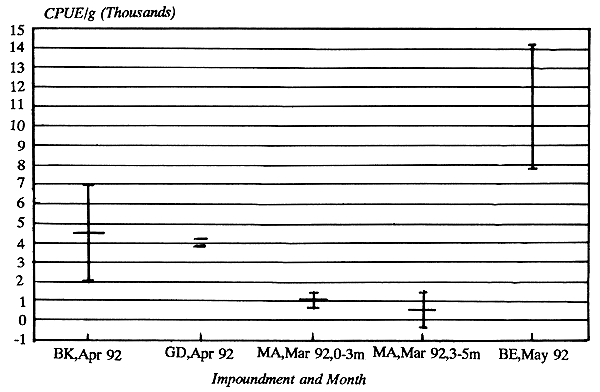Semarule dam
During the one year of test fishing, the following important observations were made:
The reservoir held a relatively good level of water throughout the year.
The tilapia, O. andersonii, breeds between November and January. Specimens with eggs/fry were caught in nets during this period.
The African catfish, C. gariepinus, caught during fishing in December, had well developed eggsacks and probably spawned during December/January.
Seasonally, just before and during the beginning of the rainy season, there is a big biomass of small Barbus spp..
Catch per unit effort was the highest during the period October to December, before the heavy rains.
People have shown interest only in bream, Labeo and catfish. No one said they ate the small Barbus spp..
Based on the above, licensed fishing with gill nets should be introduced. An individual or a group of interested fishermen should be licensed to fish with multifilament nylon gill net, with a streched mesh size of 100 – 125 mm (25m long mounted and depth 1.5–2 m), during the period February to October (273 days). To avoid the temptation to use the nets during the breeding season from November to January, the nets should perhaps be stored by the Fisheries Section.
A preliminary estimated yield for Semarule reservoir can be based on the following assumptions:
The production is roughly estimated at 200 kg/ha/year.
The reservoir keeps an annual average of 60% of the surface at full water level.
Fishing is allowed only during February to October (274 days).
The production is very low or zero during two of the breeding months and for the two coldest months. Thus the production period is eight months.
If these assumptions are made, the reservoir's yield = area when full × 60% × number of productive months/12 × estimated yield/ha/year or 37 × 0.6 × 8/12 × 200 = 2974 kg/year.
Results from fishing with monomesh multifilament nets in Semarule showed that between 7.1 and 12.8 kg was caught (May 1992) in each net (50–62mm bar height). The average catch per net was 10.5 kg. If fishing is allowed with one gill net during 274 days of the year, the annual catch will be 274 × 10.5 kg = 2877 kg. It is likely that the fisherman will not fish all of the days allowed. This means further lowering the annual yield, which will be less than the estimated annual yield. This will allow for catch from other methods.
Depending on the fisheries and marketing strategy chosen, an individual or a group of fishermen (to be identified) can set one net every day or seven nets once a week when someone can come and collect the catch. This reservoir is located 14 km from the big Molepolole village and 45 km from Gaborone. As indicated in the market study, it should be relatively easy to find a market for the fish catch.
If the actual catch is lower than the estimated annual yield, licences for more gill nets can be issued, so long as test fishing and/or a catch statistics don't indicate a decreasing fish population. No fishing with nets should be allowed in the shallow zone around the inlet. This area will be important as a breeding area and for shelter. It is relatively well protected, as trees and bush make the use of both gillnets and seine difficult.
Since gill nets were shown to catch a relatively large number of catfish, longlines should not be introduced at this stage. If fishing with longline should be introduced at a later stage, it could also be licensed and restricted to the period February – October to avoid disturbance to fish breeding (see Section 5.4.2).
Fishing with hook and line or “night-line” (one hook per line) by local residents should be allowed throughout the year without license. Visiting leisure fishermen could be charged per day visit, the fee to be collected by the Dam Group. The group could sell visitors numbered tickets stamped with the Fisheries Section logo.
Mmakgodumo
In Mmakgodumo reservoir, O. andersonii was the only existing species. There were many small-size fish: maximum size 270 mm, 365 g. The reservoir dried out totally during 1992. If it is to be restocked, it may be advisable to introduce a “mild” predating species (such as C. gariepinus if swampy areas are present) that can control overcrowding resulting from the prolific breeding of O. andersonii. This may increase productivity.
Well-regulated gill net fishing is suggested for this dam. A more intensive management, semi-intensive fish farming, can be chosen, with stocking of bream and perhaps another species from a hatchery every year. Alternatively, a breeding/fry production area can be created in the reservoir. Harvesting with gill nets and seines could be done at the end of the dry season (before the heavy rains), leaving some broodstock and the small fry.
This reservoir is just outside Kanye village, 65 km from the town Lobatse and 85 km from Gaborone. Marketing the catch should not be any problem, unless semi-intensive fish-farming generates a great quantity of fish.
Mamokhasi
This is a deeper (8 m) relatively new reservoir in a rocky area. The CPUE from test fishing was quite low, indicative of lower production. This may increase after some time. Supplementary stocking of bream can then be done and a regulated gill net fishing introduced.
For the time being a suggestion would be to try cage-farming of bream since the reservoir is relatively deep, keeps water all year (it did so even during the 1992 drought), and is not eutrophic. Allowable production has yet to be discussed. Feeding of fish in cages may have the positive effect of adding nutrients to the reservoir and thus increasing natural fish production.
This reservoir is also located just outside the Kanye village.
Bonwapitse
This reservoir has a very nice riverlike setting. It is situated along the main road between Mahalapye and Shoshong. It is thought to be an attractive spot for leisure fisheries. Good angling species can be additionally stocked, and fees charged for each visit or for fish caught.
Dikabeya
This is so far the biggest reservoir constructed by the WDS. When full it covers an area close to 130 ha. A project on forestry and environmental protection has included the stocking of fish in the project proposal. There should be good scope to introduce regulated gill net fishing here. It may also be possible to introduce cage farming.
Other reservoirs
Reservoirs that keep water for at least 7–9 months of the year can be utilized for extensive fish farming, with stocking every year and an intensive period of harvesting using gill nets and seines. The species for stocking should preferably be an indigenous bream species since it is already an appreciated food fish that is well appreciated and commands a good market price.
In other smaller reservoirs, where net fishing is not practical on a day-to-day basis, introduction or improvement of hook and line fisheries could be a good strategy. Posters illustrating hook and line fishing can be put up at health clinics and in schools.
Table 1. Characteristics of the 11 selected reservoirs at full water level.
| Name of dam | Construction year | Surface area (ha) | Max depth (m) |
| “Gaborone ponds” | N/A | 3 | 4 |
| Gakgatla | 1982 | 3 | 2 |
| Gampudi | 1968 | 14 | 7 |
| Letlhakane (Mokgalwana) | 1967 | 9 | 3 |
| Mmakgodumo (Mmakgodungwe) | 1930–33 | 20 | 3 |
| Moshupa | 1969 | 28 | 7 |
| Semarule | 1984–87 | 37 | 3.5 |
| Thaone | N/A | 3 | 2 |
| Mamokhasi | 1987 | 14 | 8 |
| Bokaa (*) | 1992 | 600 | N/A |
| Gaborone (*) | 1987 | 1900 | N/A |
Figures from Water Development Section (WDS), Ministry of Agriculture, from time of construction
(* - WUC reservoirs).
Table 2. Species found in reservoirs test-fished
| Species | GA | GK | GP | LE | MM | MO | SE | TH | BK | GD | MA |
| MORMYRIDAE | |||||||||||
| Marcusenius macrolepidotus (Mma) | X | ||||||||||
| CICHLIDAE | |||||||||||
| Chetia flaviventris (Cfl) | X | X | |||||||||
| Oreochromis andersonii (Oan) | X | X | X | X | X | X | X | X | X | X | |
| Oreochromis macrochir (oma) | X | ||||||||||
| Pseudocrenilabrus | X | ||||||||||
| philander (Pph) | |||||||||||
| Tilapia rendalli (Tre) | X | X | |||||||||
| Tilapia sparrmanii (Tsp) | X | X | |||||||||
| CYPRINIDAE | |||||||||||
| Barbus mattozi (Bma) | X | X | |||||||||
| Barbus paludinosus (Bpa) | X | X | X | X | X | X | |||||
| Barbus unitaeniatus (Bun) | X | X | |||||||||
| Barbus trimaculatus (Btr) | X | X | X | X | X | X | X | X | X | ||
| Cyprinus carpio (Cca) | X | ||||||||||
| Labeo molybdinus (Lmo) | X | X | X | X | X | X | |||||
| Labeo ruddi (Lru) | X | X | X | ||||||||
| Mesobola brevianalis (Mbr) | X | X | |||||||||
| SCHILBEIDAE | |||||||||||
| Schilbe mystus (Smy) | X | X | X | X | |||||||
| CLARIIDAE | |||||||||||
| Clarias gariepinus (Cga) | X | X | X | X | X | X | X | X | X |
GA=Gampudi
GK=Gakgatla
GP=Gaborone ponds
LE=Letlhakane
MM=Makgodumo
MO=Moshupa
SE=Semarule
TH=Thaone
BK=Bokaa
GD=Gaborone
MA=Mamokhasi
| Species | Bokaa | Gaborone | Mamokhasi 0–3m | Mamkhasi 3–6m | Semarule |
| Marcusenius macrolepidotus (Mma) | 134 (211) | ||||
| Chetia flaviventris (Cfl) | 11 (19) | ||||
| Oreochromis andersonii (Oan) | 564 (165) | 688 (899) | 262 (230) | 9416 (3207) | |
| Tilapia sparrmanii (Tsp) | 56 (111) | ||||
| Barbus mattozi (Bma) | 754 (587) | ||||
| Barbus paludinosus (Bpa) | 181 (180) | X | |||
| Barbus unitaeniatus (Bun) | 20 (39) | 280 (121) | |||
| Barbus trimaculatus (Btr) | 1162 (300) | 148 (8) | 638 (171) | 94 (113) | 597 (314) |
| Labeo molybdinus (Lmo) | 102* (116) | 350 (267) | 466 (597) | ||
| Mesobola brevianalis (Mbr) | X | ||||
| Schilbe mystus (Smy) | 3022 (125) | ||||
| Clarias gariepinus (Cga) | 2552 (2395) | 50 (101) | 196 (358) | 489 (996) | 304 (920) |
| Total | 4561 (2456) | 4050 (203) | 1095 (423) | 583 (928) | 11063 (3204) |
* = also includes a few L ruddi.
X = caught in separate 6.25 and 8 mm mesh
Table 4. Water quality parameter in the fished reservoirs 03/92–05/92
| Reservoir/Depth | (m) | Date | Temp (°C) | DO (mg/1) | pH | Transp (m) |
| Bokaa | 0 | 01–03/04/92 | 23.8 | 7.0 | 8.13 | 0.80 |
| Gaborone | 0 | 06–09/04/92 | 24.1 | 0.55 | ||
| 1 | 23.9 | |||||
| Mamokhasi | 0 | 25–27/03/92 | 24.1 | 9.0 | 8.84 | 0.37 |
| 1 | 23.1 | |||||
| 3 | 22.5 | 5.0 | ||||
| 5 | 21.5 | |||||
| Semarule | 0 | 19–23/05/92 | 20.3 | 19.0 | 0.20 | |
| 1 | 16.3 | 11.0 |
Table 5. Results from fishing with multifilament nylon gill nets, Semarule reservoir, December 1991.
25 m mounted length of 5 different mesh sizes, nets set 17.50-05.55.
| Meshsize mm bar height | No of nets | Species | Avg wt per net (kg) | Avg No per net | Avg wt per specimen (g) |
| 62 | 7 | O. andersonii | 12.1 | 20.8 | 576 |
| C. gariepinus | 5.5 | 2.5 | 2200 | ||
| 57 | 5 | O. andersonii | 9.6 | 17.4 | 551 |
| C. gariepinus | 4.3 | 2.4 | 1792 | ||
| 50 | 5 | O. andersonii | 9.2 | 20.1 | 458 |
| C. gariepinus | 6.8 | 4.4 | 1545 | ||
| 38 | 1 | O. andersonii | 3.3 | 13.0 | 257 |
| C. gariepinus | 3.1 | 2.0 | 1540 | ||
| L. molybdinus | 0.5 | 2.0 | 272 | ||
| 31 | 1 | O. andersonii | 1.8 | 10.0 | 175 |
| C. gariepinus | 2.8 | 3.0 | 947 | ||
| L. molybdinus | 0.1 | 1.0 | 128 |
Table 6. Results from fishing with multifilament nylon gill nets, Semarule reservoir, May 1992.
25 m mounted length of five different mesh sizes, nets set 17.35-07.10 (13h35 effective fishing).
| Meshsize mm bar height | No of nets | Species | Avg wt per net (kg) | Avg No per net | Avg wt per specimen (g) | Avg length per specimen (mm) |
| 62 | 2 | O. andersonii | 8.3 | 14.5 | 572 | 314 |
| C. gariepinus | 4.5 | 2 | 2259 | 668 | ||
| 57 | 2 | O. andersonii | 7.7 | 14.5 | 529 | 308 |
| C. gariepinus | 3.9 | 2 | 1928 | 614 | ||
| 50 | 2 | O. andersonii | 5.8 | 11 | 523 | 304 |
| C. gariepinus | 1.3 | 1 | 1337 | 557 | ||
| 38 | 2 | O. andersonii | 1.2 | 2.5 | 484 | 289 |
| C. gariepinus | 3.1 | 2 | 1527 | 577 | ||
| 31 | 2 | O. andersonii | 1.3 | 3 | 433 | 285 |
| L. molybdinus | 0.6 | 1 | 633 | 354 |
Table 7. Results from fishing with multifilament nylon gill nets, Bokaa reservoir, April 1992
25 m mounted length of four different mesh sizes, nets set 17.50-07.10 (13h20 effective fishing).
| Meshsize mm bar height | No of nets | Species | Avg wt per net (kg) | Avg No per net | Avg wt per specimen (g) | Avg length per specimen (mm) |
| 62 | 4 | C. gariepinus | 2.2 | 1.2 | 1732 | 626 |
| 50 | 2 | C. gariepinus | 7.0 | 6.5 | 1074 | 531 |
| 38 | 2 | C. gariepinus | 2.6 | 4.5 | 573 | 430 |
| 31 | 2 | L. ruddi | 0.6 | 3.5 | 183 | 266 |
| C. gariepinus | 1.0 | 3.5 | 252 | 337 |
Table 8. Results from fishing with multifilament nylon gill nets, Gaborone reservoir, April 1992.
25 m mounted length of five different mesh sizes, nets set 17.50-06.40 (12h50 effective fishing).
| Meshsize mm bar height | No of nets | Species | Avg wt per net (kg) | Avg No per net | Avg wt per specimen (g) | Avg length per specimen (mm) |
| 62 | 3 | O. andersonii | 2.33 | 4 | 582 | 316 |
| 57 | 3 | O. andersonii | 1.25 | 3.5 | 534 | 295 |
| C. gariepinus | 0.51 | 0.3 | 1517 | 613 | ||
| 50 | 3 | O. andersonii | 1.95 | 5.3 | 366 | 274 |
| C. gariepinus | 0.52 | 0.7 | 778 | 482 | ||
| B. mattozi | 0.11 | 0.3 | 326 | 335 | ||
| T. rendalli | 0.12 | 0.3 | 350 | 270 | ||
| S. mystus | 0.06 | 0.3 | 178 | 281 | ||
| 38 | 3 | O. andersonii | 0.38 | 2.7 | 144 | 204 |
| C. gariepinus | 0.12 | 0.3 | 350 | 385 | ||
| B. mattozi | 1.59 | 5 | 317 | 329 | ||
| T. rendalli | 0.11 | 0.7 | 168 | 232 | ||
| S. mystus | 3.24 | 10 | 324 | 313 | ||
| Labeo spp. | 0.62 | 1.7 | 373 | 314 | ||
| T. sparrmannii | 0.04 | 0.3 | 122 | 188 | ||
| 31 | 3 | O. andersonii | 0.18 | 1.7 | 109 | 187 |
| B. mattozi | 1.17 | 5.3 | 234 | 298 | ||
| T. rendalli | 0.06 | 0.7 | 98 | 177 | ||
| S. mystus | 3.95 | 23 | 172 | 279 | ||
| Labeo spp. | 0.69 | 2.7 | 258 | 277 | ||
| T. sparrmannii | 0.16 | 1.7 | 93 | 172 | ||
| M. macrolepid. | 0.36 | 2.3 | 156 | 254 |
Table 9. Catch in cylindrical wire mesh trap in Gaborone reservoir (15h00 effective fishing).
| Date | Time | Species | No | Tot Wt/g | Avg wt/g |
| 30/11/92 | 17.00-8.00 | B. mattozi | 1 | 36 | 36 |
| B. trimaculatus | 9 | 106 | 12 | ||
| 01/12/92 | 17.00-8.00 | B. trimaculatus | 44 | 529 | 12 |

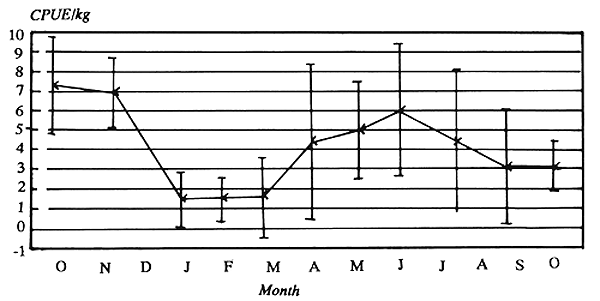
LENGTH FREQUENCY

LENGTH FREQUENCY

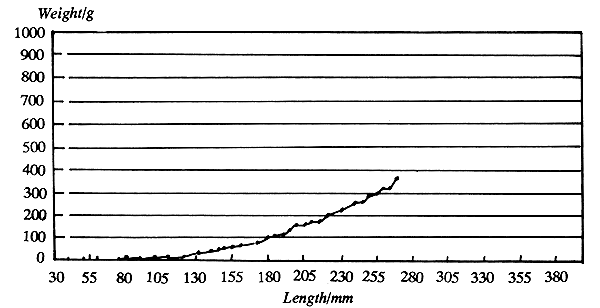
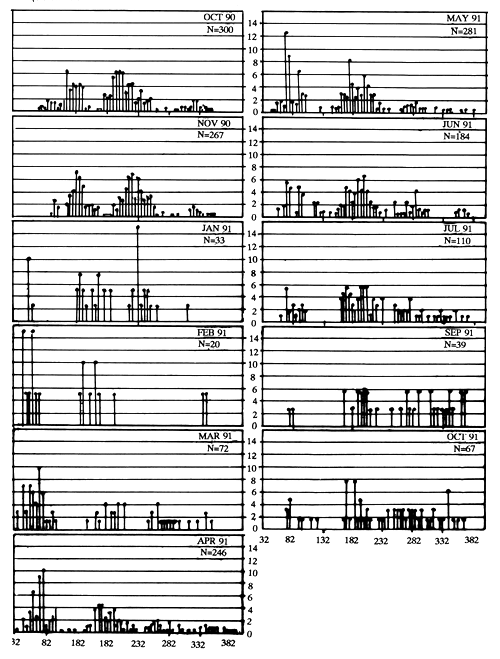
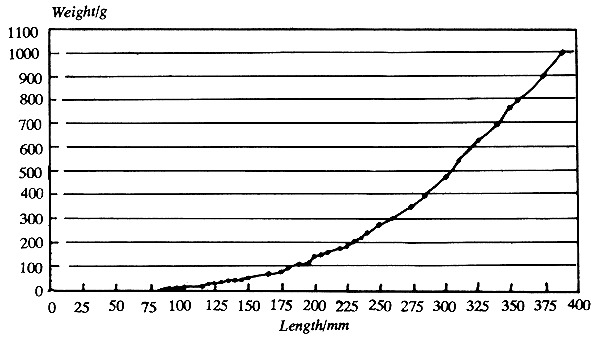
Figure 7. Temperature in Semarule, Oct 90 – Oct - 91,
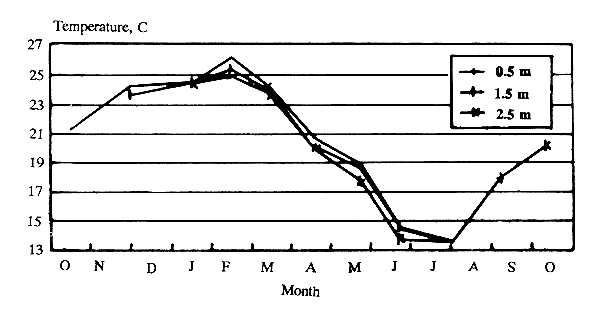
Figure 8. pH and transparency in Semarule, Oct 90 – Oct 91.

